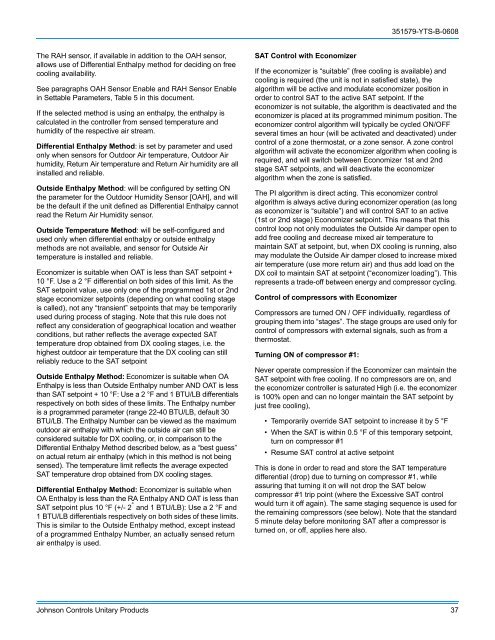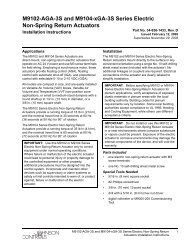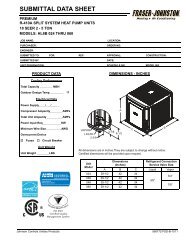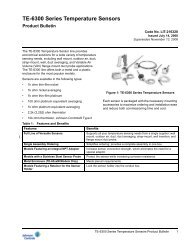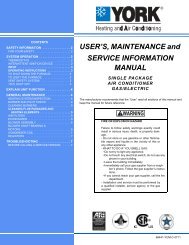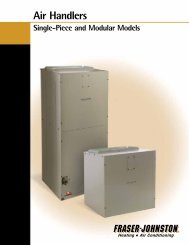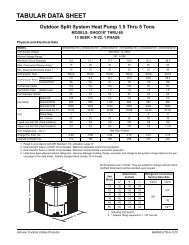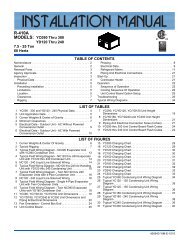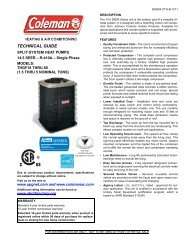analog to digital converter . . . . . . . . . . . . . . . 4 - UPGNet
analog to digital converter . . . . . . . . . . . . . . . 4 - UPGNet
analog to digital converter . . . . . . . . . . . . . . . 4 - UPGNet
Create successful ePaper yourself
Turn your PDF publications into a flip-book with our unique Google optimized e-Paper software.
351579-YTS-B-0608The RAH sensor, if available in addition <strong>to</strong> the OAH sensor,allows use of Differential Enthalpy method for deciding on freecooling availability.See paragraphs OAH Sensor Enable and RAH Sensor Enablein Settable Parameters, Table 5 in this document.If the selected method is using an enthalpy, the enthalpy iscalculated in the controller from sensed temperature andhumidity of the respective air stream.Differential Enthalpy Method: is set by parameter and usedonly when sensors for Outdoor Air temperature, Outdoor Airhumidity, Return Air temperature and Return Air humidity are allinstalled and reliable.Outside Enthalpy Method: will be configured by setting ONthe parameter for the Outdoor Humidity Sensor [OAH], and willbe the default if the unit defined as Differential Enthalpy cannotread the Return Air Humidity sensor.Outside Temperature Method: will be self-configured andused only when differential enthalpy or outside enthalpymethods are not available, and sensor for Outside Airtemperature is installed and reliable.Economizer is suitable when OAT is less than SAT setpoint +10 °F. Use a 2 °F differential on both sides of this limit. As theSAT setpoint value, use only one of the programmed 1st or 2ndstage economizer setpoints (depending on what cooling stageis called), not any “transient” setpoints that may be temporarilyused during process of staging. Note that this rule does notreflect any consideration of geographical location and weatherconditions, but rather reflects the average expected SATtemperature drop obtained from DX cooling stages, i.e. thehighest outdoor air temperature that the DX cooling can stillreliably reduce <strong>to</strong> the SAT setpointOutside Enthalpy Method: Economizer is suitable when OAEnthalpy is less than Outside Enthalpy number AND OAT is lessthan SAT setpoint + 10 °F: Use a 2 °F and 1 BTU/LB differentialsrespectively on both sides of these limits. The Enthalpy numberis a programmed parameter (range 22-40 BTU/LB, default 30BTU/LB. The Enthalpy Number can be viewed as the maximumoutdoor air enthalpy with which the outside air can still beconsidered suitable for DX cooling, or, in comparison <strong>to</strong> theDifferential Enthalpy Method described below, as a “best guess”on actual return air enthalpy (which in this method is not beingsensed). The temperature limit reflects the average expectedSAT temperature drop obtained from DX cooling stages.Differential Enthalpy Method: Economizer is suitable whenOA Enthalpy is less than the RA Enthalpy AND OAT is less thanSAT setpoint plus 10 °F (+/- 2 ° and 1 BTU/LB): Use a 2 °F and1 BTU/LB differentials respectively on both sides of these limits.This is similar <strong>to</strong> the Outside Enthalpy method, except insteadof a programmed Enthalpy Number, an actually sensed returnair enthalpy is used.SAT Control with EconomizerIf the economizer is “suitable” (free cooling is available) andcooling is required (the unit is not in satisfied state), thealgorithm will be active and modulate economizer position inorder <strong>to</strong> control SAT <strong>to</strong> the active SAT setpoint. If theeconomizer is not suitable, the algorithm is deactivated and theeconomizer is placed at its programmed minimum position. Theeconomizer control algorithm will typically be cycled ON/OFFseveral times an hour (will be activated and deactivated) undercontrol of a zone thermostat, or a zone sensor. A zone controlalgorithm will activate the economizer algorithm when cooling isrequired, and will switch between Economizer 1st and 2ndstage SAT setpoints, and will deactivate the economizeralgorithm when the zone is satisfied.The PI algorithm is direct acting. This economizer controlalgorithm is always active during economizer operation (as longas economizer is “suitable”) and will control SAT <strong>to</strong> an active(1st or 2nd stage) Economizer setpoint. This means that thiscontrol loop not only modulates the Outside Air damper open <strong>to</strong>add free cooling and decrease mixed air temperature <strong>to</strong>maintain SAT at setpoint, but, when DX cooling is running, alsomay modulate the Outside Air damper closed <strong>to</strong> increase mixedair temperature (use more return air) and thus add load on theDX coil <strong>to</strong> maintain SAT at setpoint (“economizer loading”). Thisrepresents a trade-off between energy and compressor cycling.Control of compressors with EconomizerCompressors are turned ON / OFF individually, regardless ofgrouping them in<strong>to</strong> “stages”. The stage groups are used only forcontrol of compressors with external signals, such as from athermostat.Turning ON of compressor #1:Never operate compression if the Economizer can maintain theSAT setpoint with free cooling. If no compressors are on, andthe economizer controller is saturated High (i.e. the economizeris 100% open and can no longer maintain the SAT setpoint byjust free cooling),• Temporarily override SAT setpoint <strong>to</strong> increase it by 5 °F• When the SAT is within 0.5 °F of this temporary setpoint,turn on compressor #1• Resume SAT control at active setpointThis is done in order <strong>to</strong> read and s<strong>to</strong>re the SAT temperaturedifferential (drop) due <strong>to</strong> turning on compressor #1, whileassuring that turning it on will not drop the SAT belowcompressor #1 trip point (where the Excessive SAT controlwould turn it off again). The same staging sequence is used forthe remaining compressors (see below). Note that the standard5 minute delay before moni<strong>to</strong>ring SAT after a compressor isturned on, or off, applies here also.Johnson Controls Unitary Products 37


